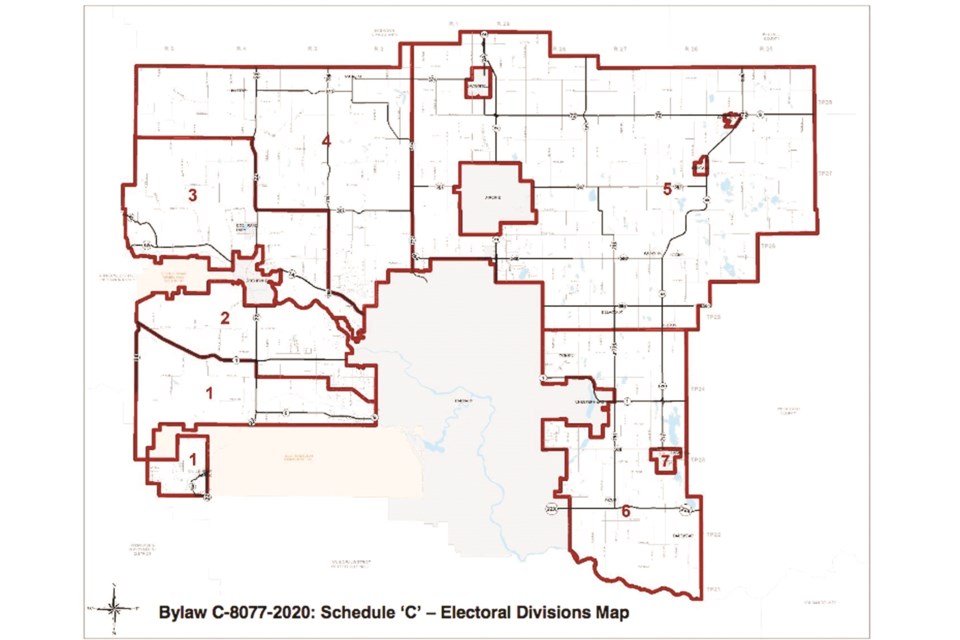Rocky View County (RVC) council will soon consider a proposed bylaw that, if passed, would reduce the number of its members by two.
The Electoral Boundaries and Council Composition Bylaw is the culmination of the County’s Electoral Boundaries and Governance review, which began last year. Council will discuss the bylaw at its Oct. 27 meeting.
“Under the Alberta Municipal Government Act (MGA) – sections 148 and 150 – council has the authority to make changes to its divisional boundaries, the number of councillors on council, and to elect or appoint the chief elected official – mayor – through the passing of a bylaw,” a post in the election section of RVC’s website stated.
In July 2019, RVC council approved the Electoral Boundary Review Policy (EBRP), outlining the process and criteria for how the division boundaries would be reviewed. The policy stipulated that population would be the main priority, but future growth, consistency, easily identifiable boundaries, communities of interest and diversity within divisions would also be considered.
The reason for the review, according to the EBRP, was the county’s population growth since the last redrawing of divisional boundaries occurred in 2000. According to census data, the county’s population increased roughly 43 per cent from 2000 to 2018, from approximately 28,000 to 42,000 people.
RVC has also gone through four annexations since 2010 that have affected the County’s electoral boundaries, the EBRP stated.
“Having equal and effective representation is essential to any democratic electoral system," it stated. "Equal representation is the principle that all votes should have equal weight, and therefore, the number of people living in each division should be similar.”
In November 2019, council voted to retain consultants from ISL Engineering and Land Services Inc. to conduct the independent and objective review.
“The work undertaken by the consultant…included a best practices review of comparable Alberta municipalities, a population analysis to determine the current demographic context in the county, a population projection to determine anticipated demographic change in the county, a spatial analysis and the development and implementation of a public participation survey,” read the post on RVC’s website.
Currently, RVC has nine divisions, each represented by an elected councillor. According to the EBRP, four of the divisions are either above or below the province’s typically accepted population standard, as set out in the MGA. According to the 2018 census, RVC’s divisions range widely in population, from around 2,500 residents in Division 1 to approximately 7,000 in Division 4.
The proposed bylaw would see the number of divisions drop from nine to seven, meaning at least two sitting councillors would lose their seat if they all run again in the 2021 municipal election. Some councillors – including the representatives of Division 3 (Elbow Valley) and Division 2 (Springbank) – would campaign against each other for one seat.
Other potential changes would see Division 8 (Bearspaw), Division 9 (lands north of Cochrane) and portions of Division 7 (lands east and south of Airdrie) be amalgamated into two positions, while a portion of Division 5 (lands north of Chestermere) and Division 6 (lands east and north of Airdrie) would be combined into one division.
The other portion of Division 5 and Division 4 (lands south of Chestermere) would also be combined, while the hamlet of Langdon would become its own division.
According to Bart Goemans, RVC’s manager of Marketing and Communications, candidates running for council must reside in the division they seek to represent for six consecutive months prior to nomination day, which is Sept. 20, 2021.
The proposed bylaw also establishes the County’s chief elected officials – currently referred to as the reeve and deputy reeve – would instead be known as the mayor and deputy mayor. According to Goemans, the process for how a reeve and deputy reeve are currently determined would be the same for mayor and deputy mayor, meaning they would be appointed on an annual basis by the sitting councillors.
“The only change occurring is regarding the title of what the chief elected official is called," he said.
The rationale for why the review settled on seven divisions will be made public at the Oct. 27 council meeting, Goemans added.
Scott Strasser, AirdrieToday.com
Follow me on Twitter @scottstrasser19



